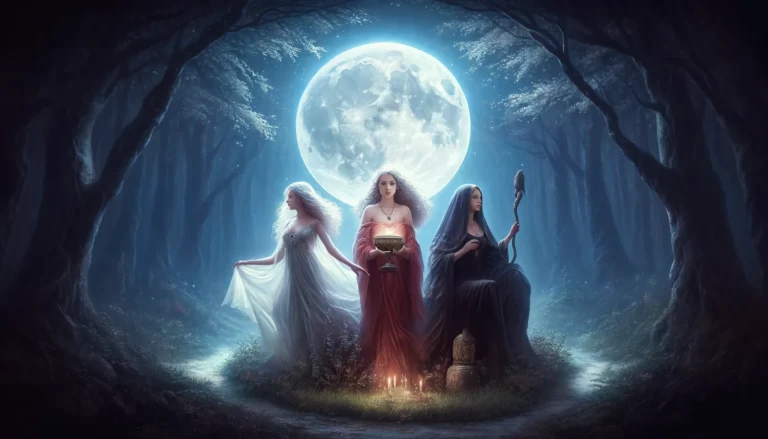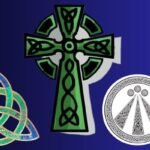Many Wiccan and Neo-Pagan traditions venerate the triple goddess, who manifests as the maiden, mother, and crone.
They represent past, present, and future, and also the cycle of life and death as new growth, fertility, and death.
She aligns with the cycles of the moon, with the maiden the waxing moon, the mother the full moon, and the crone the waning moon.
While the triple goddess of Wicca is a modern phenomenon, largely developed in the early 20th century, it draws on many ancient deities and beliefs. Let’s meet some of the triple goddesses of the ancient world.
Hecate
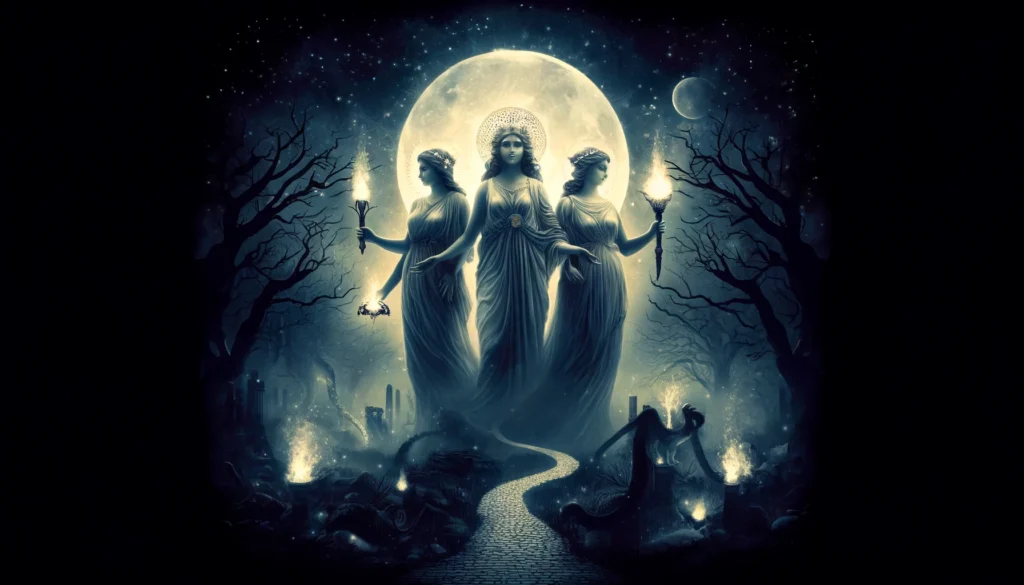
The goddess of witchcraft and the moon in ancient Greece, Hecate, was famously a triple goddess.
She was actually an old Thracian goddess adopted into the Greek pantheon.
In addition to magic and the moon, Hecate was associated with crossroads, entrances, and other liminal spaces.
She was also closely connected to the underworld and necromancy.
In the Chaldean Oracles, Hecate is described as the world soul that sits between the thoughts of God and the physical creation.
I guess that kind of makes her “the force” (yes, a Star Wars reference).
Because Hecate seems to have been a late addition to the Greek pantheon, she appears to have been “shoe-horned” in and there are a few different explanations of her origin.
The most popular is that she was the daughter of the Titans Perses and Asteria, who gave her dominion over heaven, earth, and sea.
But when Zeus went to war with the Titans, Hecate sided with him and helped him defeat the Titans.
Consequently, she was the only Titan allowed to maintain her dominion, but she was relegated to a shadow position.
As a goddess of the crossroads, her three faces look in different directions to see all.
Her icons, known as Hekataion, were commonly placed at crossroad shines, entrances to temples, and the doors of homes to stop evil spirits and negative energy from entering.
She was also associated with the moon and nighttime was her time. Night is also considered a liminal space when the veil between the worlds is thinner.
As one who could cross between worlds, Hecate was also a chthonic goddess associated with the underworld.
Interestingly, several Greek authors describe Hecate as terrible to look upon and as appearing half-living and half-dead.
The old Norse sources say the same thing about the giantess Hel.
She was born half-living and half-dead and the gods found her so terrible to look upon that they sent her to oversee the underworld so that they need not see her visage.
While she became a goddess of the underworld, she was a giant, an enemy of the gods, much as Hecate was a Titan.
Because Hecate was a Titan and not an Olympian, there seemed to be something unnatural about her gifts, which linked her with sorcery.
Hecate taught the art of sorcery to Circe, her high priestess, who taught her niece Medea.
She went on to marry Jason of the Argonauts and made a lot of trouble with her powers.
The Fates
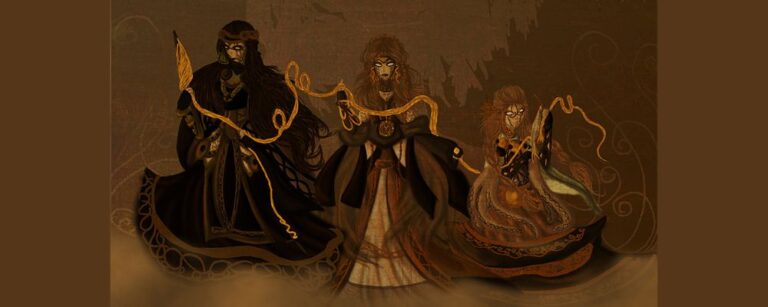
Many ancient religions have fates, and they are usually three goddess sisters.
In ancient Greece, they were known as the Moirai and were also believed to represent the three divisions of the moon.
The Greek fates were represented as a young woman, who is the spinner of the thread of life, a woman in her prime, who is the measurer, and an elderly woman, who is the cutter.
Norse mythology also has three fates, known as Norns.
They live at the base of Yggdrasil beside the well of destiny where they create fate both by inscribing runes into the bark of the tree and spinning life threads.
They also take water from the well of destiny to nourish Yggdrasil and ensure life continues.
The sisters also represent past, present, and future The eldest sister is called Urd, which means “what once was”.
The word is also used to mean just fate or death, suggesting that it was every man’s fate to die, and also that the future is the result of what once was.
The middle sister is called Verandi, which means “coming into being”.
She represents what is happening in the here and now, and her name also means birthing.
This links to the idea that a person’s fate begins at birth and that the fates attend the birth to start spinning the life thread.
The youngest sister is called Skuld, which means “that which shall be”, but her name also derives from the word for debt and suggests that fate is something that one is answerable for, and which is inescapable.
It is interesting the way that the Norse tradition inverts the ages of the fates.
While in the Greek tradition, it is the maiden who starts to spin thread and the crone that cuts it at the end of life, in the Norse tradition, it is the oldest sister who is associated with the past and the youngest with the future.
Brigid and the Morrigan
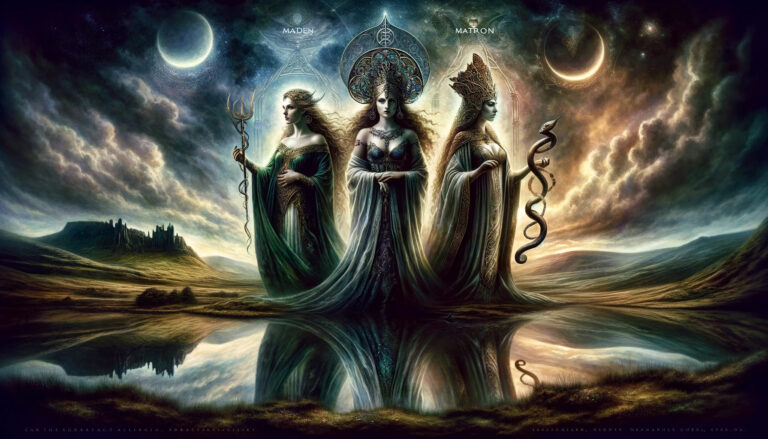
The Celtic goddess Brigid was also a triple goddess, who ruled over three important skills in Celtic society, healing, poetry, and smithcraft.
Brigid is similarly sometimes described as being three sisters, each called Brigid, but associated with each of the arts.
The Celtic goddess known as Matres or the Morrigan was also a triple goddess, but while Brigid was mostly worshiped in Celtic Ireland, votive offerings to the Morrigan appear across the Celtic world from the 1st to the 5th centuries.
She is another maiden, mother, and crone archetype.
The youngest appears with loose hair indicating maidenhood, the second with a headdress suggesting a married woman, and the final one holds a snake, suggesting death.
In the Irish tradition, she is associated with war and fate and often appears in the form of a crow.
This is an interesting parallel with Odin, who was the Norse god of war and associated with ravens.
Like Brigid, the Morrigan was sometimes imagined as three sisters, sometimes named Badb (crow), Macha (grassy plain), and Anand or Nemain (venomous).
The Triple Goddess in Modern Wicca
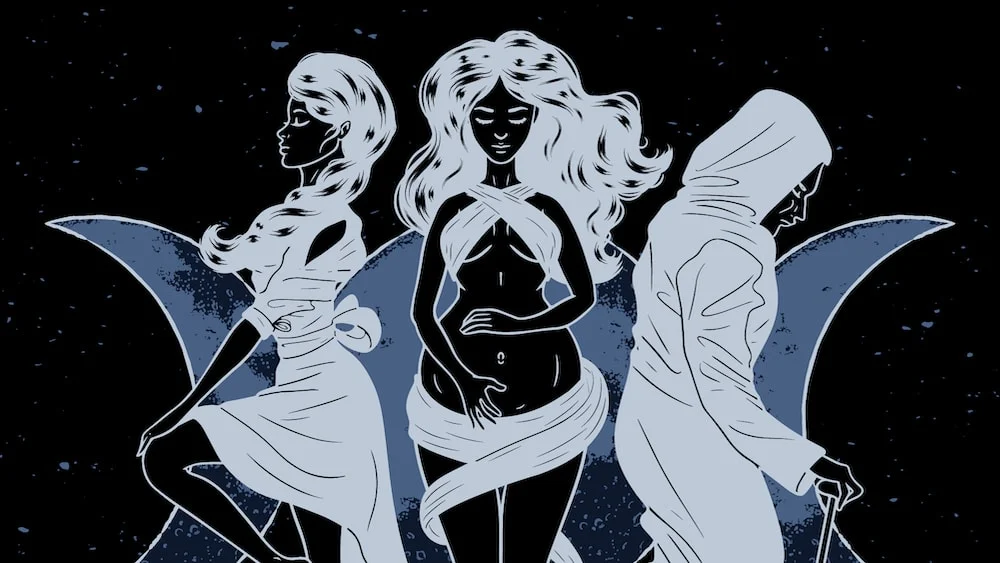
The Triple goddess in modern Wicca was largely inspired by goddesses like Hecate and was principally described for a modern age by Robert Graves in his book The White Goddess: A Historical Grammar of Poetic Myth.
This inspired his contemporary Gerald Gardner, who was in the process of developing modern Wicca.
Earlier writers also referenced the triple goddess, including Alesiter Crowley and Sigmund Freud.
The goddess was not given specific names so that practitioners could make their own associations.
For example, many modern Wiccans choose to envision the Roman goddess of the hunt Diana, the Greek goddess Persephone, or the Norse goddess Freyja as the maiden.
They might choose the Egyptian mother goddess of witchcraft Isis, the Roman goddess Ceres, or the Celtic Goddess Danu as the mother.
Often it is the Hindu goddess Kali, Hecate, or the Russian witch Baba Yaga who is the crone. Different aspects of the goddess are invoked during different magical workings.
The Maiden
The maiden aspect links with the waxing moon and the youthful phase of a woman’s life when she is in growth.
She is also associated with dawn, sunrise, and spring.
The maiden represents beauty, fresh potential, and new life and the qualities of innocence, youth, self-confidence, intelligence, and independence.
The Mother
The mother is associated with the full moon and the idea of giving birth to abundance on earth.
She is linked with midday and summer, the lushest time of year, and with forests, fields, and young animals.
She is invoked for nurturing, responsibility, adulthood, and the fullness of life.
She is often considered the most powerful of the three aspects.
The Crone
The crone is the waning moon and is associated with autumn and winter, sunset and night, and the winding down of the growing season.
She governs aging and endings, death and rebirth, past lives, transformation, visions, and divination.
Understanding the Triple Goddess
The philosophy of Neo-Paganism and Wicca is to find your own path to connection with the universe and to engage with the mythology and iconography that you connect with personally, so you can envision the triple goddess however you wish.
The important thing is that she represents the idea of past, present, and future and causality in events, and the inevitable and inescapable cycle of life, death, and renewal.
